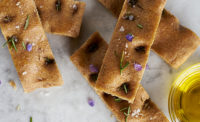Rediscovered Country
With ancient grains making a comeback, developers are seeking expert input for product creation.

SOURCE: Copyright AlenaKogotkova

Because with rare exception ancient grain flours contain no gluten, if used in a standard bread, it’s best to employ gluten “substitutes.”
SOURCE Copyright SuzanaMarinkovic


Ancient grains—or, more accurately, rediscovered whole grain cultivars—are sprouting up on menus and retail shelves across the country. You’ll find quinoa in almost any venue, while other grains, such as sorghum and millet, also are moving into mainstream dining.
Consumers, and therefore product developers, are in a time period of rediscovering foods and ingredients used hundreds of years ago. Centuries ago traditional grains, such as quinoa, sorghum, teff, millet, chia, flax, buckwheat and others, were a regular part of the food supply. Unique textures, robust flavor, protein and fiber—what’s not to love?
Figuring prominently in Asia and Africa, these grains were soon brought to the Americas for cultivation. What we now refer to as “ancient grains” haven’t necessarily been part of the global equation longer than grains more common in North American diets; they simply weren’t as prominent in our culture.
Ancient grains are attractive to the Millennial “foodie,” in part because, as a more health-conscious group, these consumers are interested in whole grains as well as transparency in the food supply. The ingredients are nutrient dense, low in saturated fats, supply a palette of unique flavors and are non-GMO. This helps contribute to their natural image and projects the “health halo” consumers are seeking in today’s market.
Compared to other grains, ancient grains typically have more nutrients. They especially are higher in protein and minerals. By using these grains as whole grains (i.e., whole grain flour, whole grain flakes, puffed whole grain, popped whole grains or cooked seeds) most of their nutritional benefits can be retained.
From a culinary standpoint, all these different ingredient formats offer a myriad of opportunities to include ancient grains in food and even beverage products. For example, whole millet flakes—cold or cooked—can be used on top of a whole grain loaf of bread or blended into a hot breakfast cereal. Nutty millet also fits in well with such confections as a decadent, sticky toffee pudding.
Keen on quinoa
When the word “quinoa” (keen’-wa) began showing up on menus, many consumers avoided trying it likely from the fear of how to pronounce the word. Today, most consumers are not only familiar with the ingredient, they also are aware of the healthy benefits and favorable texture of quinoa. Quinoa is one of the more well-known ancient grains to find success in the food industry, with global launches of new products containing it rising five-fold between 2008 and 2013 (according to Innova Market Insights).
But quinoa’s natural flavor at first created some hard challenges for product developers. It can be inherently bitter due to the layer of saponin (a soaplike glycoside compound) on its exterior.
When preparing quinoa, chefs should rinse or soak the grain to rinse off the saponin. However, it also is possible to play off its naturally bitter flavor profile by pairing it with opposing flavors, such as adding sweet and acidic ingredients—tomatoes and lemon—as a counterbalance.
Quinoa can be effectively used in such formulations as a creamy style risotto with tomatoes and lemon, or prepare lemon dill quinoa with an earthy, fatty fish such as salmon or cod.
When cooked properly, quinoa almost bursts in the mouth. It’s highly palatable and easy to digest. Quinoa is one of the only grains that also contain a complete protein. This quality helps make quinoa easier for creating vegetarian or vegan products that help consumers get their daily requisite protein needs.
Sampling sorghum
Sorghum is still on the fringe of general consumer awareness in all but the South. However, its use is suddenly growing. Highly versatile, sorghum can be used in multiple formats for food products. It typically is made into a molasses-like syrup and can be used in most applications as a 1:1 replacement for honey and molasses. Sorghum molasses can enhance items as delicately flavored as French toast or as hearty as whole grain pancakes.
In a baking, 50% to 75% (by weight) of sugar can readily be replaced with sorghum molasses. Note: In cookie and cake formulas containing baking powder, sorghum molasses will counteract the baking powder. (If a formula calls for only baking soda, it will work.) This is because sorghum molasses is acidic, and so is baking powder. Baking soda works best, because it is alkaline and balances the acidity.
When cooking sorghum as a whole grain, it should first be toasted in a dry sauté pan until it becomes slightly fragrant and slightly golden brown. This brings out the nuttiness of the grain and adds some deeper flavor notes into the dish. It is best slow-cooked about 30 minutes, uncovered, with a water ratio of 1:4. The whole grain is excellent for side dishes such as pilaf; or as part of a paella; or even simply cooked and tossed with fresh herbs such as cilantro or thyme, with a little lemon.
Another exciting way to use sorghum is to pop the whole grain like popcorn. Pour a single layer of sorghum into a pan with a little oil. Cover; turn the heat to medium and wait to hear it popping rapidly. It makes a flavorful and attractive alternative to traditional popcorn.
Sorghum flour can be used as a thickener in soups, but using sorghum flour by itself creates a less-than-palatable finished product, because it tends to be gritty, hard and dry. Still, because of the lack of gluten, sorghum can be used successfully as part of a gluten-free flour mixture.
Tapioca starch is added to most gluten-free flours to help provide some volume to baked goods. Apple cider vinegar can also be added to help relax dough and give added volume. When making gluten-free cookies or snack bars, sorghum flour proves to be a valuable ingredient. From veggie burgers, jambalaya and savory pancakes to muffins and cookies, sorghum is a welcome addition.
Millet on the Menu
Millet is another versatile ancient grain fast becoming a mainstream ingredient. Millet is not only a gluten-free alternative, to wheat; it also is highly dense in nutrients, including fiber, B-complex vitamins, essential amino acids and phytochemicals. When combined with a legume, millet is sufficient as a complete protein.
As a whole grain, millet benefits from a 30 minutes soaking and rinsing stage prior to cooking. This will soften the grain somewhat so it will cook thoroughly. In terms of functionality, millet reacts similarly to sorghum as a whole grain or as flour; however millet is a much harder grain.
Millet flour, while becoming common in gluten-free flour blends, often requires additional help from alternative ingredients, such as tapioca starch, gums and vinegars.
When making dough with millet flour, it is necessary to use hot water in place of tepid. The heat is needed to fully ‘bloom’ the starches and make the dough pliable. As an example, millet flour is used in making Bajra roti, a traditional Indian flatbread. If hot water is not used, the final bread product will crumble when it is rolled it out.
Group Your Grains
More packaged food products are using ancient grains as substitutes, or in addition to, traditional grains. Some applications include chia seeds in yogurt or cookies, sorghum in baked goods, millet in breads and crackers, or quinoa in salads and breadings.
Because (with rare exception) these ancient grain flours contain no gluten, if incorporated into a standard dough or bread, it’s best to mix them either with gluten “substitutes,” as noted above or, if a gluten-free label is not sought, with flours that do contain gluten. Usage levels can range up to 40% or 50%. A combination of three ancient grains, quinoa, sorghum and millet, mixed with bread flour can be used to formulate an excellent pizza dough.
The ancient grains help create a hearty, crusty dough with a nice bite and mouthfeel. Top with a pesto style sauce for a brighter taste than traditional marinara, but anything from traditional toppings to more unique selections will work on a crust made with ancient grains.
Sorghum and millet are such hard grains they absorb water very differently compared to traditional wheat—it takes longer for sorghum or millet to absorb moisture. In a dough or bread, processors should increase the water content in order to fully hydrate the grains.
In these cases, the use of gums or dough conditioners can help create a more pleasing, acceptable texture. These ancient grains make great candidates as ingredients for crackers, wholesome cookies, muffins and other quick breads.
Today’s consumers are drawn toward more simple, nutritious foods, and they want to know the origins of the foods they eat. Ancient grains meet these demands and then some, with ease. And, ancient grains can add enough fiber to enable a manufacturer to make a label claim.
The rediscovery and popularity behind ancient grains seem to be a natural fit for food manufacturers and consumers alike. In the near future, ancient grains will move beyond muffins and breads or cereals to deeper in the snack food aisle.
With the growing rate of snacking as a food trend, combined with the shrinking amount of time people have to prepare foods, ancient grains in their various forms can help developers create bars, chips and puffed snacks that are nutrient dense, lower in saturated fats and rich in flavor compared to conventional snack varieties.
Quick Tasting notes
Millet: Millet is a hard grain, often used as flour, where it’s toasted first and then ground into a fine powder. More mild in flavor than quinoa or sorghum, millet is quite versatile and can be used in dishes from pudding to breads. Millet is available as a whole grain, flour, flake and puff. It can also be used as part of an inclusion for cereals, snacks and bars, and in breadings.
Quinoa: Naturally bitter, quinoa must be soaked or rinsed before use. Pair up quinoa with opposing flavors that have sweet or acidic profiles. Its high protein content makes quinoa a welcome addition to dishes from salads to risotto. Flaked varieties are appearing in cereals and breads.
Sorghum: White or sweet sorghum provides the best flavor profile for multiple uses, from pastas to cupcakes or breads. On its own, it is a little bitter and very nutty in flavor. Sorghum has a less assertive flavor than quinoa. Due to its nutty, dense flavor profile, it pairs nicely with walnuts or pecans in a muffin or sweet bread formulation.
Looking for a reprint of this article?
From high-res PDFs to custom plaques, order your copy today!








